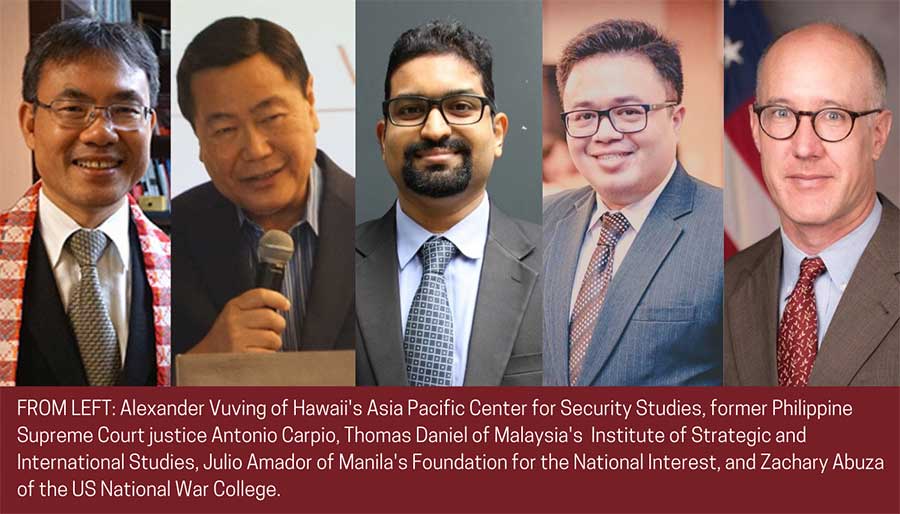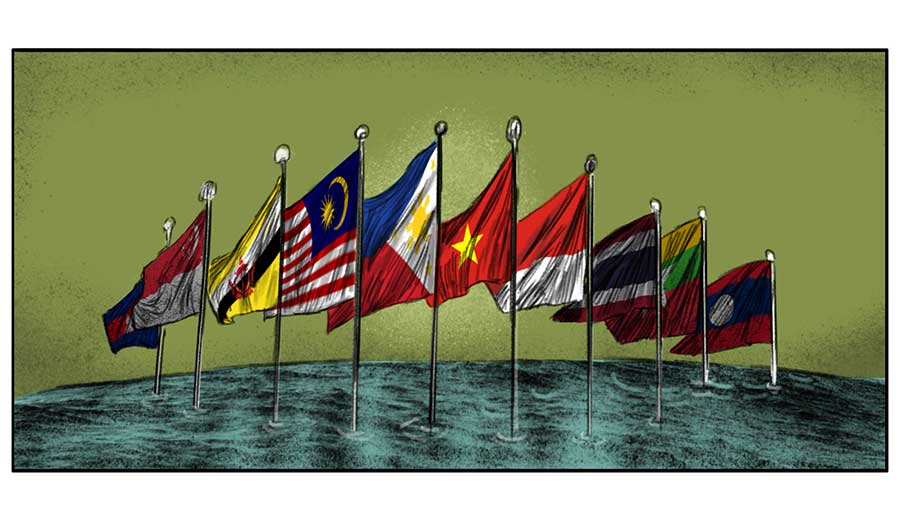
By Carmela Fonbuena, Philippine Center for Investigative Journalism
It was Christmas Day, but instead of celebrating with their families back home, a group of fishermen from Barangay Cato in the Philippine coastal town of Infanta in Pangasinan sailed to Scarborough Shoal, a rich fishing ground off the coast of neighboring Zambales province that China occupied in 2012 following a standoff with the Philippines.
Grounded for several weeks due to bad weather, the Filipino fishermen sailed off as soon as the winds calmed down.
They have limited access inside the shoal, where fish is most bountiful, but village official Alfredo Barnachea said it was better than nothing. Chinese vessels used to drive the Filipinos away from their traditional fishing ground, depriving them of their livelihood. They now let them fish around it. In at least one instance, during bad weather, they were allowed to take shelter inside the shoal.
“Sana mapag-usapan nang maigi na ‘yan. Wala na ‘yung ganoong harang harang para maaliwalas ‘yung mga mangingisda na makapangisda doon sa dapat nilang pupuntahan. (We hope they’ll be able to talk it out. Fishermen should not be blocked and should be allowed to fish in the area),” Barnachea told the Philippine Center for Investigative Journalism (PCIJ) in a phone interview.
He knew it was not guaranteed.
In November, in another part of the South China Sea, Chinese coast guard vessels used water cannons to block Philippine boats en route to resupply troops stationed at a wrecked ship at Ayungin (Second Thomas) Shoal. The shoal is inside the Philippine exclusive economic zone (EEZ), upheld by a 2016 ruling of the Permanent Court of Arbitration (PCA) that dismissed China’s nine-dash-line claim over almost all of the South China Sea. Beijing does not recognize the decision, however.
The new incident in Ayungin Shoal set in motion another diplomatic protest from Manila, one of at least 183 this year alone. Philippine Foreign Affairs Secretary Teodoro Locsin Jr said it underscored the urgency of completing the Code of Conduct (COC) that the Association of Southeast Asian Nations (Asean) was negotiating with China. It’s a framework that he said “went nowhere.”
The proposed COC will not settle which country owns what in the waters where billions of dollars in trade pass through yearly. It was intended to provide mechanisms to avoid miscalculations as the waters become increasingly militarized, and to manage tensions so that skirmishes do not escalate if miscalculations do erupt.
The COC had been compared with the Code of Unplanned Encounters at Sea (CUES), an agreement reached at the 2014 Western Pacific Naval Symposium that provides navies safety guidelines to avoid collisions, ensure safe speeds and distances, and establish radio communication procedures.
The Philippines also proposed a provision in the COC calling for the “respect of the exercise of traditional fishing rights by fishermen… [and] access to features and fishing grounds,” based on a report published on The Diplomat.
The Philippines is the country coordinator for the talks with Beijing. In August 2018, Asean and China announced a Single Draft Negotiating Text for the COC, offering hopes that the mechanism could work.
But before Locsin’s latest statement, President Rodrigo Duterte in August 2019 had already expressed concerns about delays.
Asean subgroup

Four analysts and observers raised the need for a subgroup or coalition within Asean in separate interviews with the PCIJ in the wake of Locsin’s statement.
They said the smaller grouping could be composed of four Asean member-states with claims in the South China Sea — the Philippines, Vietnam, Malaysia, and Brunei. Indonesia could be the fifth member because of its concerns over the Natuna Islands, which is not part of Beijing’s nine-dash-line claim over the disputed waters but have seen frequent visits from Chinese vessels.
“The best that I could see happening would be if the claimant states acted independently of Asean. Minilateralism is the only way forward,” said Zachary Abuza, an expert on Southeast Asia at the US National War College in Washington.
Antonio Carpio, a former justice of the Philippine Supreme Court who has led an information campaign on the country’s sovereign rights over the disputed seas, said Asean’s decision-making process, which requires a consensus, has shackled the 10-member bloc.
“The five Asean coastal states prejudiced by China’s nine-dash line should form a coalition of the willing to oppose China’s hegemony and bullying in the South China Sea,” Carpio said.
“The most urgent concern is for Asean to demand that China respect the maritime zones of the five Asean coastal states as guaranteed under Unclos (United Nations Convention on the Law of the Sea) to which China and all Asean coastal states are parties,” he added.
Abuza said the coalition should be led by Indonesia. Carpio said it should be led by the Philippines.
The proposal to create a subgrouping within Asean had been previously discussed among South China Sea observers. It was revived amid the urgency of a pushback against an increasingly aggressive China.
The subgrouping should also lead the drafting of the COC to manage tensions in the disputed waters, they added.
Julio Amador, interim president of the Foundation for the National Interest, a think tank based in Manila, was initially optimistic that Asean could play a significant role in managing the conflicts. He wasn’t anymore.
The problem, said Amador, was that the vision of a united Asean negotiating with China didn’t happen. “It became an 11-country discussion, which is a completely different creature,” Amador said.
“Now I think it’s time. It may be a little late actually. Maybe we should get all the claimant countries within Asean first to sit down,” he said.
Thomas Daniel, a senior fellow at Malaysia’s Institute of Strategic and International Studies (ISIS), said a subgrouping was one way to move forward, although he was not optimistic that even the claimant countries could unite.
“We’re talking about mitigating tensions in the maritime domain, right? I think it should be primarily led by the member-states that have a direct stake, the littoral states. And they could be supported by other Asean member-states that have direct interest in supporting the positions of the former,” he said.
“I would argue that Asean’s role is at best to play a supporting role to its member-states that have legitimate interests in the South China Sea. To me that would be a much more promising way of moving forward,” he said.
Alexander Vuving, a Hanoi-born professor at the Asia Pacific Center for Security Studies (APCSS) in Hawaii, has dismissed the COC as a “vain ambition” following China’s buildup in the disputed seas and its rejection of the 2016 PCA ruling.
“Against this background, Asean can only maintain its relevance by sticking to the accepted international law, especially Unclos and the PCA rulings, rather than seeking a compromise between the freedom and openness of the sea and China’s demands,” Vuving said.
Unequal importance of South China Sea to member-states

Daniel said he was not surprised that the COC did not move forward as its proponents had initially hoped. The South China Sea dispute does not weigh equally to all Asean member-states, he said.
“Not everyone thinks that Asean should be leading that issue in the South China Sea,” he said.
Other Asean member-countries have a separate dispute with China over the Mekong River, a trans-boundary river that flows through China, Myanmar, Thailand, Laos, Cambodia and Vietnam.
The damming of the river by China and Laos limited water supply to neighboring countries. “But how often do you see these issues being raised by Malaysia, Philippines, and Indonesia?” said Daniel.
Abuza said Asean has “proven feckless in resolving” several issues — not just the South China Sea dispute and the damming of the Mekong River, but also the civil war in Myanmar. He cited several member-states’ dependency on China due to debts and other economic entanglements.
But this does not make Asean irrelevant, said Daniel. “It does have an influence. That is why everyone watches what it says… If China has its way, these statements won’t even be there.”
“The fact that Asean as a group continues to express concerns on developments in the South China Sea and take efforts to mitigate them is itself important… I guess what people are upset about is that perhaps there is a lot more that can be done,” he said.
The role of the Asean chairman, rotated among member-countries, would continue to be important, Daniel added. “The chair needs to be able to tread this fine line and balance between the legitimate interests of its member-states and the association and obviously pressure and influence coming from external actors. Beijing is able to play that pressure on certain member-states but not all.”
Cambodia, whose pro-Beijing stance has prevented a regional consensus on the South China Sea dispute, will serve as Asean chairman in 2022.
Resolve internal issues first
China has taken advantage of the delay in the sea code of conduct to change the facts in the disputed waters, an indication of China’s lack of sincerity, experts said.
Beijing fortified its artificial islands further. It also passed a Coast Guard law that allowed the use of force, contrary to the peace and stability that the proposed COC envisioned. These moves undermined the future of the COC, experts said.
Apart from the Philippines, the other Asean states in the proposed coalition have had a spate of high-profile skirmishes with China in the past decade.
Earlier in the year, Beijing reportedly demanded Indonesia to stop drilling oil and gas off the waters of Natuna Islands, which it said was Chinese territory.
In 2019, before the pandemic, China sent its ships off Sarawak to engage Malaysia in a standoff over the deployment of West Capella, a drillship contracted by Malaysia’s state-owned energy company Petronas. Vietnam also sent its ships.
In 2014, China and Vietnam had a similar standoff after Beijing planted an oil rig inside Vietnam’s exclusive economic zone. It led to deadly anti-China riots in Vietnamese cities.
“China chooses when and how to escalate, and against whom. They are careful not to pick fights with more than two of the claimants at a time, for fear of a collective response,” said Abuza.
A coalition of five member-states could launch a more effective pushback against China, analysts said. But the subgrouping would have to resolve their own territorial disputes first, they said.
“We need to show first and foremost that among the claimant countries, we can actually start discussions without having to threaten anybody. In the first place, we shouldn’t seek China’s permission because internally within Asean, we have issues in the South China Sea,” said Amador.
Abuza agreed. “Until the claimant states resolve their own differences and come up with a common position, nothing will happen. China takes advantage of this very effectively,” he said.
“Even if Asean didn’t have consensus-based decision-making, I’m not sure if the grouping would confront China. But let me say this: China is afraid of a multilateral and unified Asean response. If it wasn’t, it wouldn’t put such efforts into keeping the organization divided,” he said.
Internationalization of the dispute
Meanwhile, the world’s militaries have joined the US in pushing back China in the South China Sea, further militarizing the waters. In April 2021, the European Union announced a new policy to step up its presence in the region.
“You cannot now divorce it from the whole geopolitics of the region. They do have fundamental interests particularly the freedom of the seas, trade, freedom of navigation, and the ability to travel to these areas. They will protect those interests,’ said Amador.
Internationalizing the dispute might be the best way forward, analysts said.
“Others think that because Asean and other member-states are not really capable of managing this by themselves — and realistically they are just not — maybe it is a good idea to internationalize this as much as possible,” said Daniel.
But even as Asean relies on alliances to push back Beijing, analysts said further increasing tensions in the region was the last thing the 10-member bloc wanted.
Whatever happens to the COC talks, the analysts cautioned against a document that is ultimately dictated by Beijing.
A sneak peek of the COC talks, based on an article on The Diplomat, said China had proposed to insert a provision to exclude companies from outside the region from any cooperation. Malaysia reportedly opposed it, proposing instead a provision stating that nothing in the COC “shall affect… rights or ability of the Parties to conduct activities with foreign countries or private entities of their own choosing.”
In his recent statement, the Philippines’s Locsin also opposed “the exclusion of any outside power from the South China Sea.”
Vuving offered a warning: “China will only endorse a Code of Conduct that reflects and reinforces a China-led hierarchical order, not an order based on neutral rules such as Unclos. The Code of Conduct, if accepted by China, will have the job of surreptitiously endorsing China’s faits accomplis, including its violations of Unclos as confirmed by the PCA in its 2016 rulings.”
Such outcome would make things worse for some claimant states, said Amador. It also wouldn’t be acceptable to external stakeholders that would need to be bound by the same code of conduct.
It’s not just Asean’s relevance that is on the line, analysts said, but peace and stability in the region.
For the fishermen of Barangay Cato in Infanta, they asked for their livelihood to be protected. “Ang gusto lang namin ay makapangisda sila ng maayos at maraming silang mahuli (Our only wish is they can fish in peace and bring home a bountiful catch,” said Barmachea.
Illustrations by Joseph Luigi Almuena
This report was produced as part of the Seafore ASEAN Masterclass project, with support from the Institute for War and Peace Reporting



















